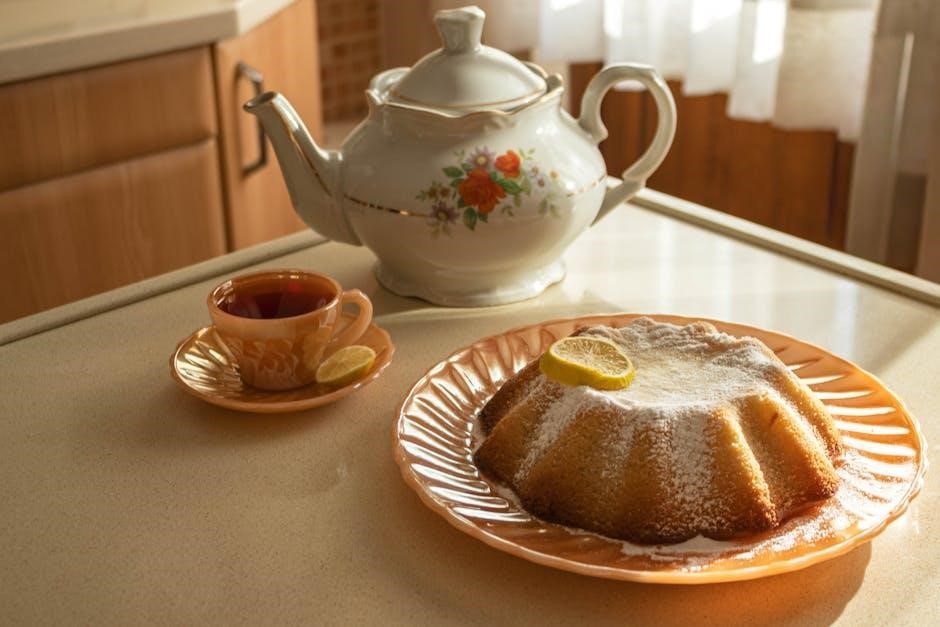The Cup of Caterpillars offers a hands-on STEM experience, allowing children to observe the fascinating transformation from caterpillar to butterfly, promoting educational exploration and biology learning through observation.
Overview of the Cup of Caterpillars Concept
The Cup of Caterpillars is an interactive STEM educational tool designed to let children observe the life cycle of Painted Lady butterflies. Each cup contains 5 tiny caterpillars, food, and a safe environment for growth. The concept allows kids to witness the transformation from caterpillar to chrysalis and finally to a butterfly, fostering curiosity and learning. The kit is user-friendly, with clear instructions provided by Insect Lore, a trusted source for over 50 years. It’s perfect for both home and classroom use, making biology accessible and fun while promoting an appreciation for nature and science; The experience creates lasting memories and encourages STEM exploration.
Importance of the Cup of Caterpillars for Educational Purposes
The Cup of Caterpillars is a hands-on educational tool that engages students in STEM learning by observing the life cycle of butterflies. It aligns with science curricula, teaching concepts like metamorphosis, biology, and ecosystems. The interactive nature fosters curiosity, critical thinking, and scientific inquiry. Students develop observation and recording skills, making it ideal for classroom activities. It also promotes responsibility as children care for the caterpillars. This unique experience bridges science with creativity, encouraging students to explore and understand natural processes. It’s a valuable resource for educators, making complex biological concepts accessible and fun for young learners.

Unboxing and Initial Preparation

Unboxing the Cup of Caterpillars begins with carefully opening the package and inspecting its contents, followed by initial setup to prepare for the caterpillars’ arrival;
What Comes in the Cup of Caterpillars Kit
The Cup of Caterpillars kit includes a clear plastic cup for observation, live caterpillars, a food source tailored for their dietary needs, and a comprehensive instruction booklet. Additionally, the kit may contain a lid or mesh top to ensure proper airflow and prevent escape. Some versions include a magnifying glass or observation tools to enhance the learning experience, along with a growth tracking chart to monitor the caterpillars’ development. The kit is designed to be a self-contained educational tool, providing everything necessary to raise the caterpillars and observe their transformation into butterflies.
Preparation Steps Before Introducing Caterpillars
Before introducing caterpillars to the cup, ensure all materials are clean and ready. Wash your hands thoroughly to avoid transferring any contaminants. Examine the cup for any damage or debris and clean it with mild soap and water if necessary. Place the cup in a safe, stable location away from direct sunlight and pets. Read the instruction manual carefully to understand the setup process. Allow the cup to reach room temperature if it was stored in a cool place. Wait for the caterpillars to arrive before preparing the food source, as it may spoil if left unused. Ensure all components are assembled correctly for optimal caterpillar growth.
Safety Precautions When Handling Caterpillars and Cups
When handling caterpillars and their cups, prioritize cleanliness and gentle care. Always wash your hands before and after handling the caterpillars to prevent transferring harmful substances. Avoid exposing the cup to direct sunlight or extreme temperatures, as this can harm the caterpillars. Never touch the caterpillars excessively, as their delicate bodies can be injured. Handle the cup with care, ensuring it is secure and won’t tip over. Supervise children when they interact with the cup to ensure safety. Follow the provided instructions carefully to avoid any potential risks. Keep the cup out of reach of pets to prevent accidental damage.

Caring for Your Cup of Caterpillars
Maintain a stable environment, monitor condensation, and provide proper nutrition to ensure healthy growth and development of your caterpillars. Regular observation and gentle handling are essential.
Placing the Cup in the Right Environment
Place the cup in a stable, room-temperature environment (68-78°F) away from direct sunlight, drafts, and extreme temperatures. Avoid areas near pets or young children to prevent disturbance. Ensure the cup is on a flat, secure surface to maintain balance and prevent tipping. Keep it away from windows to avoid overheating or cooling fluctuations. Do not place the cup near heating vents, radiators, or air conditioning units, as this could disrupt the caterpillars’ natural development process. Proper placement ensures optimal conditions for growth and transformation.
Checking for Condensation Inside the Cup
Regularly inspect the cup for condensation, which can form due to the caterpillars’ breathing and environmental moisture. Excessive condensation may lead to mold or hinder healthy development. To check, gently tilt the cup and look for water droplets on the sides or lid. If condensation is heavy, use a clean, dry cloth to softly blot the inside without disturbing the caterpillars. Ensure the cup is not overly sealed to allow airflow. Excessive moisture can be managed by placing the cup in a well-ventilated area. Proper management prevents issues and supports healthy growth. Always handle the cup carefully to avoid harming the caterpillars.
Feeding Instructions for the Caterpillars
The caterpillars in your Cup of Caterpillars are provided with a nutritionally balanced food source upon arrival. Typically, no additional feeding is required, as the kit includes all necessary nutrients. However, monitor their food supply to ensure it remains fresh and plentiful. Avoid overfeeding, as this can lead to contamination. Gently place the cup on a stable surface during feeding to prevent disrupting the caterpillars. Keep the cup clean by removing frass (caterpillar waste) regularly. Maintain proper airflow to prevent mold growth. Follow the feeding schedule provided in the instructions to ensure optimal growth and health for your caterpillars.
Monitoring the Growth and Health of Caterpillars
Regularly inspect the caterpillars for signs of healthy development, such as active movement and proper eating habits. Check for natural molting cycles, as this is a normal part of growth. Ensure the caterpillars are consistently eating the provided food and avoid overcrowding. Look for any discoloration or sluggish behavior, which may indicate health issues. Track their size increases and note shedding of skin as they grow. Maintain a clean environment by removing frass and uneaten food to prevent contamination. Observe their behavior daily to catch any early signs of distress. Use a journal to document their progress and ensure a healthy transformation process.
The Transformation Process
The Cup of Caterpillars reveals the magical journey from caterpillar to butterfly. Observe the stages of growth, transformation into a chrysalis, and emergence as a beautiful butterfly. Patient observation is key to witnessing this natural wonder. Each phase offers unique changes, showcasing the beauty of metamorphosis and the cycle of life. This hands-on experience provides a fascinating look at nature’s incredible processes.
Understanding the Caterpillar Stage
The caterpillar stage is the first phase of metamorphosis, where the larvae consume food to grow rapidly. During this period, caterpillars shed their skin multiple times to accommodate their increasing size. Proper nutrition and a clean environment are crucial for healthy growth. Observing the caterpillars daily allows you to note changes in size, color, and appetite. This stage is essential for building energy reserves needed for the upcoming transformation. By following the care instructions, you can ensure the caterpillars thrive and reach their full potential before entering the chrysalis stage. This phase is foundational for the entire metamorphosis process.
Observing the Chrysalis Formation

The chrysalis stage is a critical transformation period where the caterpillar evolves into a butterfly. After attaching itself to a surface, the caterpillar forms a silk pad and undergoes a dramatic change. The chrysalis may appear still, but inside, remarkable metamorphosis is occurring. It’s important to avoid disturbing the chrysalis, as this could disrupt the process. Keep the cup in a stable, undisturbed environment and maintain proper humidity. Observing the chrysalis daily allows you to monitor its condition and anticipate the butterfly’s emergence. This stage typically lasts several weeks, depending on the species. Patience is key as nature unfolds its magic.
Watching the Butterfly Emerge
The moment of emergence is a magical experience. As the butterfly begins to exit the chrysalis, you’ll notice slight movements and color changes. Keep the cup still and avoid touching the delicate process. Mist the cup lightly with water to maintain humidity, aiding the butterfly’s wings in expanding properly. Be patient, as full emergence can take several hours. Once free, the butterfly will pump fluid through its wings to expand them fully. Allow it to rest for 24 hours before releasing it, ensuring its wings are strong and dry. This moment is a rewarding culmination of careful observation and care.

Tips for Optimal Results
Tips for Optimal Results
For the best experience, ensure the cup is placed in a stable, warm environment and avoid direct sunlight. Maintain consistent humidity levels and provide fresh food regularly.
Positioning the Cup for Best Observation
To maximize your observation experience, place the cup in a well-lit area with indirect natural light to avoid overheating. Ensure the cup is stable and on a flat surface, away from drafts. Position it at eye level for easy viewing, especially for children. Keep the cup away from direct sunlight, which can cause condensation buildup. Avoid placing it near heating vents or extreme temperatures. For better visibility, consider using a stand or elevation to minimize glare. This setup ensures optimal viewing angles and maintains a comfortable environment for both observation and caterpillar growth. Proper positioning enhances the educational and enjoyable experience.
Avoiding Common Mistakes in Caterpillar Care
To ensure a successful experience, avoid overfeeding or underfeeding the caterpillars, as this can disrupt their growth. Refrain from handling the caterpillars excessively, as their legs are delicate and may be damaged. Never force-feed or disturb the chrysalis, as this can harm the developing butterfly. Avoid placing the cup in direct sunlight, which can cause overheating and condensation buildup. Do not clean the cup excessively, as this may remove essential food or disrupt the caterpillars’ environment. By avoiding these common mistakes, you can create a safe and healthy space for the caterpillars to grow and transform. Proper care ensures a rewarding experience.
Keeping the Cup Clean and Hygienic
Maintaining a clean environment is crucial for the health of your caterpillars. Regularly remove frass (caterpillar waste) and uneaten food to prevent mold and bacteria growth. Gently wipe the inside of the cup with a soft, damp cloth, avoiding direct contact with the caterpillars or chrysalis. Ensure the lid is secure to maintain humidity but allow minimal airflow. Avoid using harsh chemicals, as they can harm the caterpillars. Cleaning should be done carefully to prevent disturbing the caterpillars or damaging their habitat. A clean cup promotes healthy growth and prevents contamination, ensuring a successful transformation process. Regular checks and gentle maintenance are essential for optimal results.

Troubleshooting Common Issues
Identify and resolve issues promptly to ensure caterpillar health. Address condensation, slow growth, or emergence problems by adjusting environment, diet, or hygiene. Quick action prevents setbacks.
Addressing Condensation Problems
Condensation in the cup can harm caterpillars by promoting mold growth. To fix this, gently tilt the cup to drain excess moisture or place it in a well-ventilated area. Avoid direct sunlight, as it can cause overheating and increase condensation. Use a paper towel to absorb moisture without disturbing the caterpillars. Ensure the cup’s lid is slightly ajar for airflow. Regularly check and address condensation to maintain a healthy environment. Preventing moisture buildup is crucial for the caterpillars’ survival and transformation. Monitor humidity levels and adjust as needed to keep the habitat dry and safe.
Dealing with Slow Growth or Inactivity
If caterpillars appear inactive or grow slowly, check their environment and diet. Ensure the cup is placed in a room with consistent temperatures (65-75°F) and avoid drafts. Provide fresh, nutrient-rich food daily, as stale leaves can hinder growth. Maintain proper humidity by misting the cup lightly with water. Overcrowding can stress caterpillars, so ensure enough space. Replace old food with fresh leaves regularly. Monitor for pests or mold, which can slow growth. Patience is key, as growth rates vary. Following these steps promotes healthy development and activity. A stress-free environment is essential for optimal growth.
Handling Chrysalis or Butterfly Emergence Issues
If the chrysalis falls, gently reattach it using a string or pin. Avoid touching the chrysalis excessively, as oils from skin can harm it. If a butterfly emerges with deformed wings, allow it time to expand and dry completely. Ensure the cup is clean and well-ventilated. If the chrysalis doesn’t open, check for proper humidity and temperature. Handle butterflies carefully, supporting their wings during emergence. If issues persist, consult a guide or expert; Patience is crucial, as occasional challenges are part of the natural process. Proper care ensures a successful transformation and healthy butterfly release.
Educational Value and STEM Integration
The Cup of Caterpillars offers hands-on learning, teaching life cycles, metamorphosis, and ecosystems. It fosters STEM skills through observation, critical thinking, and scientific inquiry about nature.
Connecting the Cup of Caterpillars to STEM Learning
The Cup of Caterpillars seamlessly integrates into STEM education by promoting hands-on exploration of biological processes. Students observe metamorphosis, a key scientific concept, fostering curiosity and critical thinking. The experience introduces principles of life sciences, ecology, and biology, aligning with STEM curricula. Pupils can use magnifiers or cameras to document and analyze growth stages, enhancing their understanding of scientific observation and data collection. This interactive learning tool encourages inquiry-based education, helping students develop essential STEM skills through real-world applications and exploration of nature’s wonders. It bridges theory with practical experience, making complex concepts engaging and accessible for learners of all ages.
Using the Cup of Caterpillars in Classroom Settings
The Cup of Caterpillars is an excellent educational tool for classroom settings, offering a hands-on way to teach biology and life cycles. Teachers can incorporate it into lesson plans, allowing students to observe and study metamorphosis up close. It encourages collaborative learning through group activities and discussions. The cup’s compact design makes it easy to manage in a classroom environment, while the clear container provides an unobstructed view for all students. It also supports differentiated instruction, catering to visual and tactile learners. By integrating the Cup of Caterpillars, educators can create engaging science lessons that foster curiosity, teamwork, and a deeper understanding of natural processes.
Teaching Biology Concepts Through Observation
The Cup of Caterpillars offers a unique opportunity to teach fundamental biology concepts through direct observation. Students can witness the life cycle of butterflies, from caterpillar to chrysalis and finally to a fully formed butterfly. This hands-on experience provides a visual understanding of metamorphosis, a key biological process. Observing the caterpillars’ growth, behavior, and transformation helps students grasp concepts like life stages, adaptation, and ecological roles. By documenting their findings, students can analyze patterns and connect their observations to broader biological principles. This interactive learning method makes complex concepts accessible and engaging for young learners.
Additional Resources and Refills
The Cup of Caterpillars kit often includes access to refill packs, instructional guides, and online resources. These materials help users replenish supplies and deepen their understanding.
Where to Find Refill Kits for the Cup of Caterpillars
Refill kits for the Cup of Caterpillars can be purchased directly from the official website or authorized retailers. Online marketplaces like Amazon often carry them, ensuring convenience. Educational supply stores may also stock these kits, catering to classroom needs. For the best experience, buy from reputable sources to guarantee authenticity and quality. Additionally, customer support teams can guide you to trusted sellers or provide direct links for purchases. Always verify the seller’s credibility to avoid counterfeit products and ensure your caterpillars receive the right supplies for healthy growth. Contacting customer service can also help clarify any questions about availability or compatibility.
Using Instructional Videos for Better Understanding
Instructional videos are an excellent resource for mastering the Cup of Caterpillars experience. These videos provide step-by-step guidance on caring for caterpillars, from feeding to observing their transformation. Available on the official website and platforms like YouTube, they cover topics such as troubleshooting common issues and preparing the environment. Many videos feature educators and experts sharing tips for optimal care. Watching these can help users avoid mistakes and deepen their understanding of the process. They also offer visual insights into caterpillar behavior and development, making learning engaging and accessible for both children and adults. Videos are a great way to enhance your experience and ensure success.
Accessing Online Guides and Manuals
The Cup of Caterpillars experience is supported by comprehensive online guides and manuals, available on the official website and other educational platforms. These resources provide detailed instructions on setup, feeding, and troubleshooting. They include visual aids, timelines for development, and tips for maintaining optimal conditions. Regularly updated, these guides ensure users have the latest information. Manuals are designed to be user-friendly, catering to both children and adults. They offer in-depth insights into the biology of caterpillars and butterflies, making the learning process engaging and informative. Accessing these materials is straightforward, ensuring a smooth and enjoyable experience for all participants.

Interactive Learning and Fun Activities
Engage in interactive learning with the Cup of Caterpillars by creating observation journals, crafting butterfly-inspired art, and hosting a butterfly release event for a fascinating experience.
Creating an Observation Journal

Creating an observation journal is a great way to track the progress of your Cup of Caterpillars. Start by noting daily changes, such as the caterpillars’ growth, feeding habits, and stage transitions. Include sketches or photos to document their transformation. Write down questions or hypotheses about their behavior and development. This journal not only enhances learning but also makes the experience more engaging. Encourage children to predict outcomes, like when a chrysalis might form or a butterfly will emerge. Use sticky notes for quick updates and reflections. Over time, the journal becomes a treasured keepsake and a valuable educational resource.
Engaging in Creative Activities Related to Caterpillars
Engage in creative activities to deepen your connection with the Cup of Caterpillars experience. Try drawing or painting the life cycle stages, from caterpillar to butterfly. Create stories or poems about their journey, imagining their thoughts and adventures. Kids can craft caterpillar-inspired puppets or collages using recycled materials. Hosting a caterpillar-themed party or game night can also spark fun and learning. These activities foster creativity, curiosity, and a deeper appreciation for nature. They also provide opportunities to share the experience with others, making it a memorable and enriching adventure for all ages.
Hosting a Butterfly Release Event
Hosting a butterfly release event is a magical way to celebrate the end of your Cup of Caterpillars journey. Choose a sunny day and a safe, open location for the release. Invite family and friends to witness this special moment. Before releasing, gently place the butterflies on flowers or hands for a memorable experience. Include fun activities like butterfly-themed games, speeches, or a countdown to the release. This event fosters a sense of accomplishment and connection to nature. Capture the moment with photos or videos to treasure the memory. It’s a joyful way to conclude your caterpillar-to-butterfly adventure!

Legacy and Memory Making
Raising caterpillars leaves a lasting legacy, creating cherished memories of growth, transformation, and wonder. It inspires a lifelong appreciation for nature and learning, fostering curiosity and connection.
Creating Lasting Memories with the Cup of Caterpillars
The Cup of Caterpillars experience fosters meaningful connections and lasting memories, especially for children, as they witness the magical transformation from caterpillar to butterfly. Observing the journey firsthand sparks curiosity and wonder, creating a bond with nature. Families can share in the excitement of releasing newly emerged butterflies, a moment that often becomes a cherished memory. Documenting the process in an observation journal or through photos allows users to reflect on their journey and celebrate the cycle of life. This hands-on learning opportunity not only educates but also builds a sense of accomplishment and joy that lasts long after the experience ends.
Sharing the Experience with Family and Friends
Sharing the Cup of Caterpillars journey with loved ones enhances the learning process and creates shared joy. Encourage family members to observe the caterpillars’ growth together, fostering curiosity and teamwork. Inviting friends to witness key moments, like the butterfly’s emergence, can inspire collective wonder and excitement. Discussing observations and insights with others deepens understanding and sparks meaningful conversations. This collaborative experience not only strengthens bonds but also spreads appreciation for nature’s beauty and the life cycle of butterflies. Sharing photos or updates online can further extend the excitement and connect with a broader community of caterpillar enthusiasts.
Documenting the Journey for Future Reference
Documenting the Cup of Caterpillars experience is a valuable way to track progress and reflect on the journey. Keep a journal or scrapbook to record daily observations, note changes in the caterpillars’ growth, and include photos of key milestones. This documentation helps identify patterns and deepens understanding of the life cycle. It also serves as a reference for future attempts or to share insights with others. By maintaining a detailed timeline, you can revisit the transformation process and appreciate the incredible journey from caterpillar to butterfly. This documentation becomes a cherished keepsake and educational tool for years to come.
The Cup of Caterpillars offers an enriching experience, blending education and wonder as users witness the magical transformation from caterpillar to butterfly. It fosters curiosity, patience, and a deeper connection to nature, making it an invaluable tool for learning and personal growth.
Summarizing the Cup of Caterpillars Experience
The Cup of Caterpillars experience is a captivating blend of education and wonder, allowing users to witness the incredible journey from caterpillar to butterfly. This hands-on activity fosters curiosity, responsibility, and a deeper appreciation for nature. By observing the transformation, participants gain insights into life cycles, growth, and metamorphosis. The experience encourages patience and care, making it a valuable learning tool for both children and adults. It also sparks creativity and connection, creating lasting memories. This unique opportunity to nurture and observe such a remarkable process is both inspiring and educational, leaving a lasting impact on those who participate.
Encouraging Continuous Learning and Exploration
The Cup of Caterpillars experience serves as a gateway to lifelong learning, inspiring curiosity and a love for nature. It prompts users to ask questions, explore biology, and understand the interconnectedness of ecosystems. By fostering a sense of wonder, it motivates individuals to delve deeper into STEM topics and environmental science. Encouraging creative thinking, such as drawing or writing about the process, extends the learning experience. This hands-on activity not only teaches responsibility but also sparks a desire to explore the natural world, making it a powerful tool for continuous discovery and growth.


